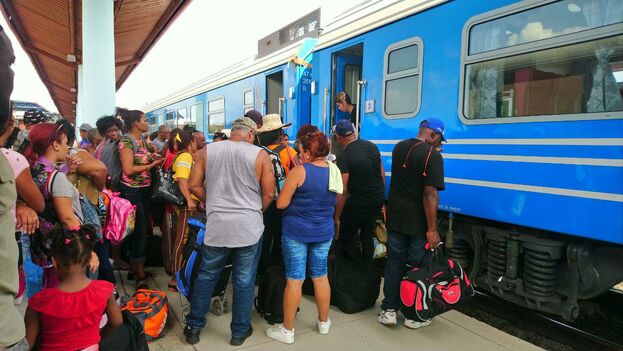
![]() 14ymedio, Madrid, 28 February 2023 — Though the Cuban Railway Union (UFC) has eighty-one Chinese locomotives in its fleet, only twenty-five are currently operable. The rest are out of service, in need of maintenance and repair. This information appears to have been buried near the end of an article in the Communist Party newspaper Granma. Though schemes to modernize Cuban rail transport have been announced any number of times, they have never amounted to much.
14ymedio, Madrid, 28 February 2023 — Though the Cuban Railway Union (UFC) has eighty-one Chinese locomotives in its fleet, only twenty-five are currently operable. The rest are out of service, in need of maintenance and repair. This information appears to have been buried near the end of an article in the Communist Party newspaper Granma. Though schemes to modernize Cuban rail transport have been announced any number of times, they have never amounted to much.
This time around the focus is to be on repair and maintenance facilities. In fact, the change is being driven by the needs of Chinese-made locomotives themselves. “It’s a technology with different characteristics than what existed before,” says Enrique Valdes Abreu, who heads the project, which began in March 2022 with the support of the French Agency for Development (AFD).
The organization, which has been active in Cuba since 2016, has five projects in the works. These involve promotion of rural development, improvement of water and sanitation services, promotion of renewable energy and modernization of public health and transport infrastructure. Its investment in all these areas to date approaches 16.2 million euros.
Previous attempts to modernize the Cuban railway system relied on large investments from Russia and China. Russia withdrew its support for one of the projects in late 2020, however, due to repeated breaches of contract by the Cuban side. On Monday, Granma reported another Russian investment deal is in the works, with Sinara Transport Machines, to repair the Chinese-made locomotives in Havana’s Cienaga workshop.
Valdes Abreu said that progress has already been made on the structural component and that part of the technological component is now in the country.
In October 2022, the UFC and Chinese Beijing Fanglian Technology signed “two letters of intent” for the gradual restoration of some of the railway’s infrastructure, an agreement that prioritized an overhaul of repair and maintenance facilities.
In even more pressing need of modernization are the Luyanó facilities (in Havana’s Tenth of October district), which were damaged by fire in December, and the San Luis facilities (in Santiago de Cuba). Both were built in the 1970s and are in serious states of disrepair, as might be expected of infrastructure built half a century ago that has not been well-maintained.
It was necessary in the case of the Havana location, says Valdes Abreu, to do a complete overhaul of the maintenance warehouse, including the building structure and lighting system. The first Chinese locomotives to arrive were the initial delivery of what will eventually total 240 machines. According to the director, the installation must be retooled to allow five trains a day to depart for the country’s interior.
A new 200-meter warehouse will be built in Luyanó to provide technology maintenance. AFD will be in charge of mitigating the impacts of pollution produced by the plant’s operations. It will rely on water treatment equipment, some of which has already been installed, to clean wastewater for reuse. The plant will also have solar panels capable able of supplying the entire facility as well as providing energy to the National Electric System.
Another new warehouse is to be built to consolidate operations currently scattered across different sites. Meanwhile, areas now in poor condition will be demolished once all their reusable materials have been salvaged.
One focus of the project will be training workers, who will have to become familiar with the manufacturer’s new technology. Valdes Abreu points out that this will create new job opportunities for transportation engineers and railroad technicians at a time when the country is finding it hard to retain talent due to low public-sector wages and poor living conditions, factors which have led certified young people to seek opportunities abroad.
The San Luis operation will also handle maintenance of the Chinese locomotives, which requires different levels of specialization. Since the current structural conditions are already optimal at this facility, new contruction is not required, a factor that will reduce investment costs.
As proposed by AFD, the plant — located in eastern Cuba — will begin operations under a pilot program. The French agency favors adopting a gradual approach, starting with the facility that has made the most progress towards modernization.
____________
COLLABORATE WITH OUR WORK: The 14ymedio team is committed to practicing serious journalism that reflects Cuba’s reality in all its depth. Thank you for joining us on this long journey. We invite you to continue supporting us by becoming a member of 14ymedio now. Together we can continue transforming journalism in Cuba.
